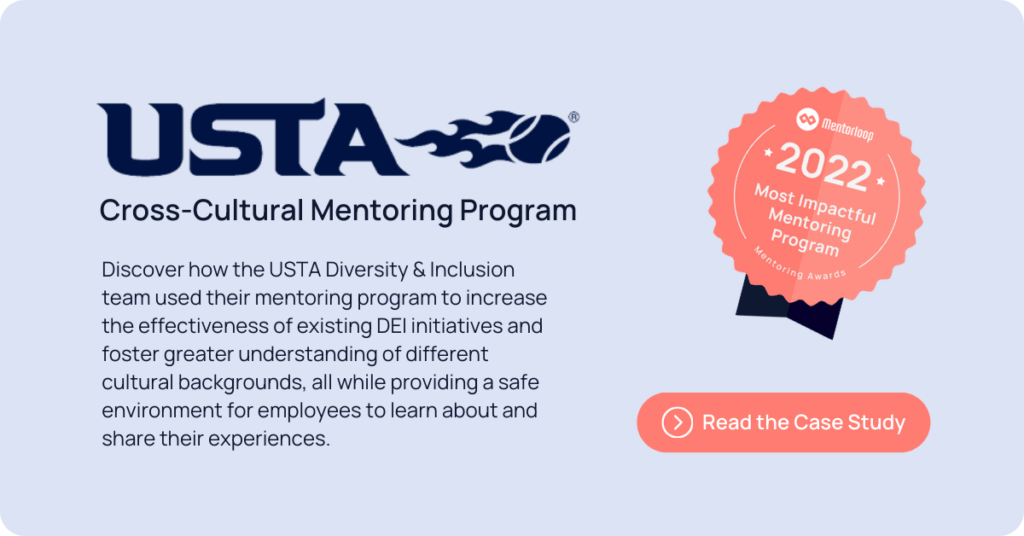Diversity and Inclusion (D&I) is a hot topic and for good reason. Inclusive teams are more engaged and productive; diverse teams have been proven to outperform non-diverse ones. In fact, a 2015 McKinsey report found that those in the top quartile for ethnic and racial diversity in management were 35% more likely to have financial returns above their industry mean. Similarly, those in the top quartile for gender diversity were 15% more likely to have returns above the industry mean.
Another study found that while the S&P 500 saw a 35.5% decline in stock performance between 2007 and 2009, companies that remained highly inclusive experienced a 14.4% gain. This means they outperformed their less inclusive peers four times over.
And when it comes to workplace diversity programs, research indicates that successful ones create more opportunities for continued engagement. What’s a great way to do that? Mentoring programs! However, not many have done it right. A number of companies running D&I mentoring programs do not execute them in the right way or are misguided in their initial approach to building the program.
So let’s take a look at the wider topic of diversity and inclusion in relation to mentoring.
Diversity or Inclusion?
Diversity and inclusion are different lenses through which to look at the same problem. As we like to say – diversity is the end goal, and inclusion is the means by which we get there. So while not mutually exclusive, hopefully, you will be able to see the marked differences between the paths of inclusion and diversity, and which one best aligns with your D&I goals.
Inclusion: The Company-Wide Approach
The inclusive approach to mentoring is a more company-wide and culturally integrated approach. It involves offering mentoring to all employees who are willing, able, and eager to participate. Approaching diversity in this way expands the scale, legacy, and institutionalisation of the program outcomes. If you can create a truly inclusive culture where all employees are encouraged to develop, interact, and voice their opinions – diversity is inevitable.
Diversity: The Individual Approach
The individual approach, on the other hand, is an approach by which a company selects minority groups or individuals to participate in the mentoring program. As a mentoring software provider, our clients often apply mentoring to very specific diversity initiatives. While this may seem intuitive and resourceful, it is often not the most effective way to foster diversity. But, it is purposeful and more easily measured. After all, it is far easier to track the outcomes of a small test group.
Our recommendation:
Find a healthy middle ground. It is unlikely that every individual within your organisation is going to want to participate in the mentoring program, so offer the program beyond a select group. This will open up the benefits of mentoring to more individuals while creating a more diverse pool of mentors and mentees who will interact and converse with one another – breaking down the artificial barriers to diversity organically – and permanently.
Diversity: Top-Down
One of the main measures of diversity, including amongst the tech giants like Google and Facebook, is diversity in the boardroom and C-suite; so mentoring for diversity up the hierarchy has become paramount. What does this look like? It involves connecting high-potential minority employees with management-level employees who can offer them advice, support, and a network with which to climb the ladder. Again, one of the bonuses of this measure is that it is easy to measure. It also comes with many trickle-down effects that disseminate throughout an organisation.
Inclusion: Bottom-Up
The inclusion approach includes worrying about diversity and inclusion across all departments, levels of authority, and experience levels. An inclusive approach involves plugging all of the leaks in a long talent funnel – from recruitment all the way to the C-suite. It involves offering mentoring as an onboarding tool to diverse hires who may need more time and care in being initiated; involves providing mentoring to junior and mid-level employees who need to continue to develop leadership and communication skills, and involves mentoring senior management and leaders.
Our recommendation:
Make mentoring an integral part of your culture. This way, you can stop trying to find temporary solutions to permanent problems. When people and culture programs are run in perpetuity and with commitment, they become embedded in the corporation. Then, you will find that the whole organisation becomes more diverse and inclusive. Upper management and senior leadership will be burgeoning with diversity, while the rest of the organisation normalises the process of internal progression based on merit – not appearance.
Diversity + Inclusion
While assessing and implementing these different ideas and strategies, we must not lose sight of the goal of diversity and inclusion. Which is not to just increase a KPI or vanity metric, but to provide a platform with equal opportunity for every person within an organisation, fostering real inclusion.
And beyond that, the strength and benefits of diversity (which are significant), stem from the intermixing of diverse backgrounds, opinions and beliefs. Having a diverse group of people standing in a room doesn’t really make that group diverse; it makes the room diverse. As has been proven time and time again, the way to overcome shallow differences and plaguing issues is to find common pursuits. Creating programs where interaction is encouraged and becomes normal practice creates a sustainable, beneficial, and diverse culture.
Most people do not want to see anyone sitting on the sidelines – minority or not. So we need to continue working on fostering work environments that ensure that no one who could or should be in the game – is left on the sidelines.
What Can Organizations Do?
We all benefit when a colleague or connection shows us the ropes, gives us a push, or sponsors us for a new opportunity. But accessing these connections is not always available to everyone.
And this is why organisations need to make mentoring more accessible, encouraged, and formalised.
Informalities create subjectivity, which create anxiety around not knowing whether you are doing the right thing. Simply formalising a process naturally normalises the process.
Let’s take the example of gender diversity and tackle the finding that almost half of male managers are uncomfortable participating in a common work activity with a woman, such as mentoring, working alone, or socialising together. Part of the rising anxiety men feel when mentoring women+ is derived from reality, but much of it is grounded in recency bias, perception, and lack of exposure to the act in question (men don’t mentor women a whole lot as it is).
By making mentoring a more formal, structured, and integral process, organisations would be giving a massive green light to mentoring, and normalising the process of men mentoring women, women mentoring men, reverse mentoring etc. They would be creating an environment whereby men and women can be comfortable with mentoring each other; an environment where it’s demystified and expected. With a formal mentoring program, organisations also have more room to create standards and frameworks that both parties can lean on and enjoy operating in.
Beyond making these mentoring programs more formal and available, mentoring also needs to be more democratic in nature. Many organisational mentoring programs are focused on HiPo employees; employees who have shown high potential and therefore should be mentored as a part of their extracurricular training in the knowledge that they are management and promotion material.
HiPo mentoring feeds straight back into the problematic cycle being perpetuated: more men are managers and executives; these male managers mentor high potentials (who are more likely to be male given they are more comfortable mentoring other men), and so more men get mentored and sponsored which then reinforces itself in a vicious and unfair cycle.
Selective mentoring (like HiPo mentoring) is less effective. It fails to capture the potential of mentoring to unlock latent talent and underserved people and groups; the 90% of people who account for the vast majority of organisational productivity. It’s critical that organisations look to programs like mentoring as company-wide tools and to focus on the role these programs can play in creating inclusivity — which then unlocks diversity.
And why reserve a mentor for high performers when everyone can benefit from a mentor — and when all mentors can benefit from helping someone else out too?

The Role of Mentoring Champions and Advocates
Mentoring champions and advocates serve as vital catalysts in cultivating an inclusive workplace culture because of their role in fostering inclusion in mentoring opportunities and within mentoring programs.
Their commitment to the principles of diversity, equity, and inclusion is the bedrock upon which successful mentoring programs are built. These champions proactively champion the cause of mentorship and advocate for its accessibility to all employees, irrespective of their backgrounds. By sharing their own positive experiences and showcasing the tangible benefits of mentorship, they inspire others to join the mentoring journey. These champions help unlock the potential of every employee, ensuring that diverse perspectives are not only valued but actively sought after within the organization. In doing so, they set the stage for a work environment where differences are celebrated, innovation flourishes, and everyone has an equal opportunity to thrive.
Furthermore, mentoring champions and advocates lead by example, modelling inclusive behaviours and attitudes. They actively seek out mentees from underrepresented groups, demonstrating a commitment to providing equitable opportunities for career development. By engaging in open conversations about diversity and inclusion, they foster a culture of dialogue and learning, helping break down barriers and biases. These champions not only enrich the mentoring experience but also contribute significantly to the broader corporate culture, where inclusivity isn’t just a buzzword but a lived reality, driving greater engagement, collaboration, and success for the entire organization.
Five Things To Remember for Successful Mentoring for Diversity and Inclusion
1. DEI is More than Race, Gender, and Sexuality
DEI programs are about more than race, gender, and sexuality. Culture, neurodiversity, disability, differences in lived experiences (e.g. experience with poverty), and other factors should be considered in order to create an effective, successful program that meets participants where they’re at.
2. If You Can, Training Your Mentors is Advisable
Many things can get lost or misunderstood between people with different lived experiences; this is why training your mentoring participants in diversity and inclusion is incredibly helpful. Encourage participants to attend sessions on active listening, asking the right questions, cultural competency, and more.
In this fireside chat, Future of Leadership and Inclusion Expert Winitha Bonney talks about the importance of “mentoring the mentors” when you’re working on building an inclusive culture:
Read the extended Q&A for this fireside chat
3. Let Participants Know That Your Organisation Backs This Initiative
Showing that your organisation is 100% behind this initiative and is dedicated to making it work will let participants know that you mean business and that the time they spend participating in the program won’t be wasted. It also encourages them to prioritise mentoring and make time for it.
Need help getting leadership on board with your program? We’ve got you covered.
4. Measurement
At Mentorloop, we’re all about the metrics. After all, measuring what’s working and what’s not is the only way to craft a program that actually works for your people. Knowing what to measure and that results will take time is essential as you start this initiative. Thankfully, our Live Sentiment Dashboard can help, providing rich quantitative data and qualitative feedback from your participants.
5. Communication with Participants is Important
Especially in the early days of your program—and if DEI has never been explored in your organisation—participants may have some questions and/or hesitation. Make sure you’re there to address these and provide support.
See how the USTA did this successfully.
Additionally, feedback is important, so make sure to ask for it, and not just at the end of the program.
Watch to see how Mentorloop manages feedback:
If you want to see how Mentorloop can help you address diversity and inclusion through mentoring, set up a 30-minute chat and demo with us:





